
This logo isn't an ad or affiliate link. It's an organization that shares in our mission, and empowered the authors to share their insights in Byte form.
Rumie vets Bytes for compliance with our
Standards.
The organization is responsible for the completeness and reliability of the content.
Learn more
about how Rumie works with partners.
It can be easy to think what that all news media is trustworthy, but it's not always that simple.

While news media focuses on providing accurate information, that info can sometimes come with bias or only share what the source thinks is relevant about a story.
Reading laterally helps you evaluate your source and consider: do you have an objective account of what's happening oris there something you aren't being told?
Vertical vs. Lateral Reading
When researching, people usually read vertically, reading through a source all at once. With vertical reading, sources are examined individually and independently from one another. There is risk, though — what if it's not as trustworthy as it looks?
Lateral reading, also known as horizontal reading, focuses on fact-checking as you go and combining yourpool ofknowledge from everything you read.
Check out this video about lateral reading from the University of Louisville:
Digital literacy expert Mike Caulfield from Washington State University has three big tips for using lateral reading as you browse internet sources:
Investigate the source
Find the original source
Look for trusted work
Quiz
Sam is trying to read an article about climate issues, but it has some new information that Sam hasn't seen before. Which lateral reading strategies should Sam use to figure out if the source is trustworthy? Select all that apply:
Remember, lateral reading is all about using information from many places to help your understanding of what you're reading. Reading to the end first is an example of vertical reading, not lateral reading.
1. Investigate the source
Who are the publishers?
While there are plenty of big-name news sources out there that people constantly use to check the news, there are also plenty of lesser-known names that might cover smaller stories like local news or overly specific topics.

Take a look at your source. Try to find:
Author info — Check at the end of the article or see if the author's name at the top links to a profile about them and their work.
About page — How does the source present themselves? Look at their goals and how they interact with their consumers.
Other sites — Do others view this source as reliable? A quick web search can tell you if they're worth your time.
2. Find the original source
Sometimes, the news media you're looking at might actually be reporting on what another source said.
Look for any times that your source refers to other sources — phrases like, "According to", or "As reported by".
You can also look for any hyperlinks to other sources. Hyperlinks can help point you towards experts and direct information about a topic.
By finding the original source, you can make sure that any outside information comes from a place you can trust.

3. Look for trusted work
Even if you're reading a big-name source, that doesn't mean you can instantly trust it. Big-name news media can include all sorts of opinionated writing based on the views of the publishers. Take a look at these headlines:
Headline 1

This headline is a neutral statement. The source will likely cover how the choice was publicized and what Trump and Sessions have to say about the events.
Read the CNN article to practice lateral reading.
Headline 2

This headline shows an opinion (disapproval). The source may cover information about the publication of the announcement and what both Sessions and Trump have to say, but it may also delve into any controversy and question how good a choice this is.
Read the Intercept article to practice lateral reading.
Both stories are covering the same topic, but how they cover the story will be different. As you read, think about whether what you see is using opinionated language and what facts the source has chosen to include.
Quiz
Is the following headline biased? "Poll Says Majority of Voters Support New Health Legislation"
While this headline refers to what the voters think, it's not giving any commentary on the results of the poll and what the author or publishers think of that information.
Did you know?
Want to look at more? Check out this page about bias in the news put together by the University of Washington!
Take Action
Remember to think critically when it comes to news media and use lateral reading as much as you can!

This Byte has been authored by
Erica Kauffman
Learning Designer | Educator